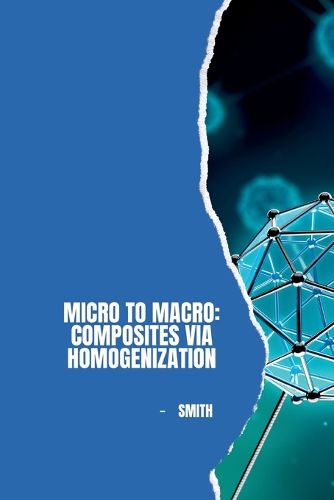Readings Newsletter
Become a Readings Member to make your shopping experience even easier.
Sign in or sign up for free!
You’re not far away from qualifying for FREE standard shipping within Australia
You’ve qualified for FREE standard shipping within Australia
The cart is loading…






A composite material is generally taken to be a material consisting of two or more constituents or phases [96]. These heterogeneities can include voids, fibers and stiff or soft inclusions and can vary in size. Any material, human-made or natural, can thus be considered heterogeneous at a particular scale. The ongoing improvement of technology over the past century has led to the rapid development of heterogeneous materials, and the need to understand the interactions between these heterogeneities. In the past, experimental test methods would be conducted on a series of material samples to determine its "effective properties" [41]. This approach has become less appealing in recent times though due to the number of resources required, such as time and money. Conversely, to accurately model the microstructure at the macroscopic level, each constituent in the heterogeneous structure would need to be modeled explicitly. While a hypothesis on the microstructural behavior at the macro scale is not required in this case, the method is often impractical due to the enormous difference in length scales between the heterogeneities and the macroscopic sample. Moulinec and Suquet [69] used Fast Fourier Transforms, with images of the microstructure, to reduce the size of the meshing, but still required computers with high memory capabilities. The application of micro modeling is thus limited to localized phenomena cases, where analysis of the microstructure is required. These include contact problems [27, 112], microstructural damage [73] and micro-cracking [40]. A parameter fitting technique was implemented by Geers [20] and Meuwissen [62] to obtain the effective property of a material's microstructure. By fitting material parameters to experimental data, one can obtain the macroscopic strain-energy function of the material. Though successful, this approach is tedious and, despite being optimized by Gendy and Saleeb [22] and Ogden et al. [72], requires large volumes of experimen
$9.00 standard shipping within Australia
FREE standard shipping within Australia for orders over $100.00
Express & International shipping calculated at checkout
A composite material is generally taken to be a material consisting of two or more constituents or phases [96]. These heterogeneities can include voids, fibers and stiff or soft inclusions and can vary in size. Any material, human-made or natural, can thus be considered heterogeneous at a particular scale. The ongoing improvement of technology over the past century has led to the rapid development of heterogeneous materials, and the need to understand the interactions between these heterogeneities. In the past, experimental test methods would be conducted on a series of material samples to determine its "effective properties" [41]. This approach has become less appealing in recent times though due to the number of resources required, such as time and money. Conversely, to accurately model the microstructure at the macroscopic level, each constituent in the heterogeneous structure would need to be modeled explicitly. While a hypothesis on the microstructural behavior at the macro scale is not required in this case, the method is often impractical due to the enormous difference in length scales between the heterogeneities and the macroscopic sample. Moulinec and Suquet [69] used Fast Fourier Transforms, with images of the microstructure, to reduce the size of the meshing, but still required computers with high memory capabilities. The application of micro modeling is thus limited to localized phenomena cases, where analysis of the microstructure is required. These include contact problems [27, 112], microstructural damage [73] and micro-cracking [40]. A parameter fitting technique was implemented by Geers [20] and Meuwissen [62] to obtain the effective property of a material's microstructure. By fitting material parameters to experimental data, one can obtain the macroscopic strain-energy function of the material. Though successful, this approach is tedious and, despite being optimized by Gendy and Saleeb [22] and Ogden et al. [72], requires large volumes of experimen